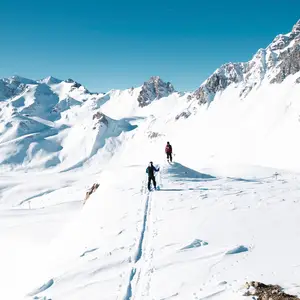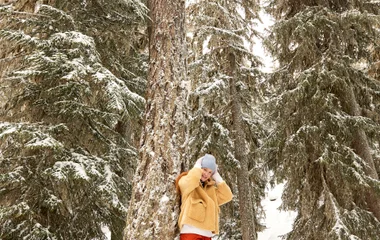When it comes to snowshoeing, there are several basic techniques to master including walking, ascending uphill, descending downhill, traversing sideways down steep hills, and breaking new trail where no other snowshoers have been. Learning these basic techniques will greatly help you as you make your first treks into nature.
First off, the walking technique. When walking on snowshoes, you'll need to take slightly wider steps than your normal walking stride to avoid stepping on your snowshoes. Lift your feet slightly higher than usual to prevent the snowshoes from catching on each other or obstacles. Keep your body upright -- beginners often hunch over, but this isn't necessary. Stay natural and relaxed.
When ascending up hills, you'll want to lean slightly forward into the slope to maintain your balance and avoid slipping backwards. Step hard to engage the crampons and traction points on the snow. This will help you maintain a better grip. Dig your toes into the snow as you step up. You may also want to shorten your steps on uphill climbs in order to conserve your energy and maintain control. Use your poles to push yourself up steep inclines. This will take some weight off your legs.
When descending downhill, you'll want to shift your weight toward your heels and lean back slightly to keep your center of balance toward the mountain. Engage your hell crampons for better traction. Keep you knees slightly bent to maintain your balance and control. You may also want to use your poles by stabbing them into the snow and moving them forward with each step.
For steep slopes, you might want to try a sidestep technique. Traverse steep slopes by angling your snowshoes across the slope rather than going straight up or down. Distribute your weight evenly across both snowshoes, keeping your body perpendicular to the slope. Use your poles for balance and to provide extra stability. Angling your body sideways can help you feel more confident that you wont slip or stumble.
The last technique you'll want to know about is meant for "breaking trail" -- this means being the first person to venture into fresh, deep snow. This is a beautiful experience, but can be more taxing as the snow has not been compacted by previous snowshoers. When breaking trail, take smaller steps and use more effort to lift your snowshoes higher out of the snow. Allow your weight to sink into the snow a bit, but avoid overexerting yourself by lifting excessively heavy snow with each step. Switch leaders periodically if you are in a group, as breaking trail can be physically demanding.
Throughout your hike, you will want to remove excess snow that has caked onto the bottom of your snowshoes because it adds extra weight for your legs to lift. In wet or sticky snow conditions, snow may accumulate on your shoes regularly. Periodically check and remove any snow build-up to maintain proper flotation. Use your poles or gloved hands to knock off the snow from the snowshoes.
In terms of safety, we recommend a few rules of practice:
Check weather conditions before heading out. Avoid snowshoeing during heavy snowfall, blizzards, or high winds.
Dress appropriately. Wear multiple layers. Avoid cotton.
Carry essential equipment, such as a map, compass, or GPS device to navigate, extra layers, plenty of water, food, a headlamp or flashlight, a whistle, a multi-tool or knife, first aid kit, and a fully charged mobile phone.
Inform others of your plans. This way, they can alert authorities if you're overdue.
Stay on marked trails. Avoid venturing into unfamiliar or unmarked areas, as they may pose hidden dangers or avalanche risks.
Be cautious of avalanche risks, especially if you're snowshoeing in mountainous areas prone to avalanches. Educate yourself about avalanche safety.
Stay hydrated and nourished by drinking plenty of water. Carry high-energy snacks or meals to maintain your energy levels.
Be aware of wildlife. Familiarize yourself with the local wildlife in the area where you're snowshoeing. Take precautions to avoid encounters with potentially dangerous animals, such as bears or cougars. Carry bear spray if necessary and know how to use it.




